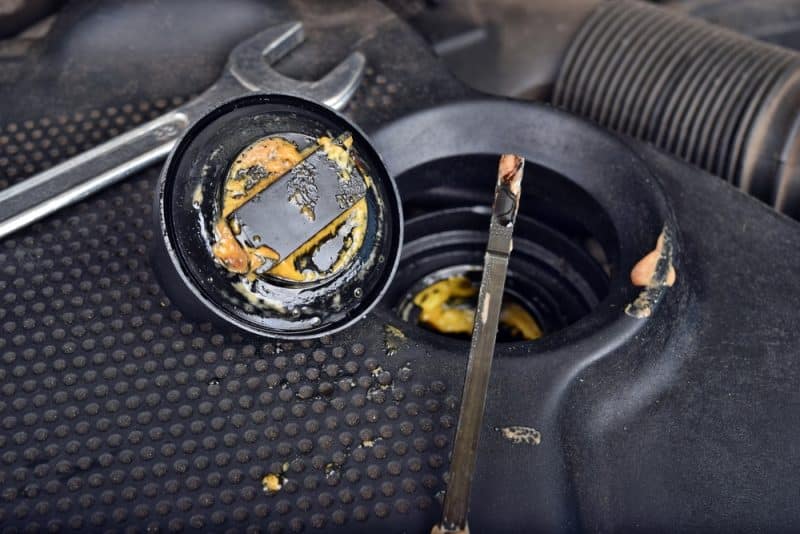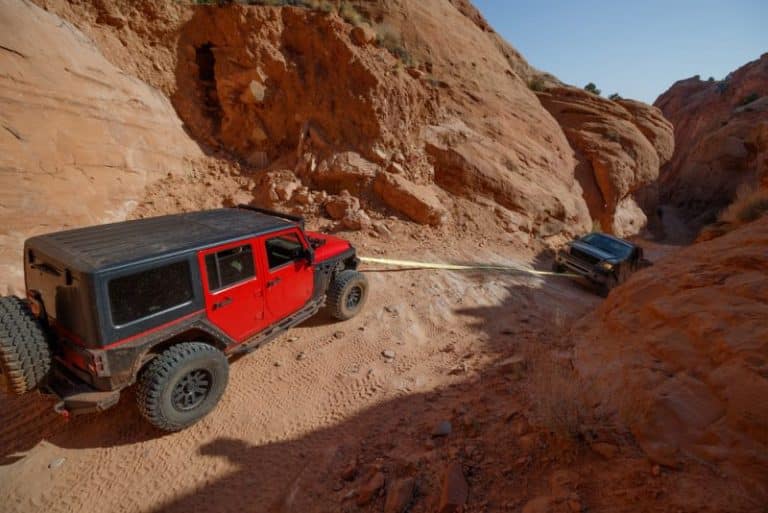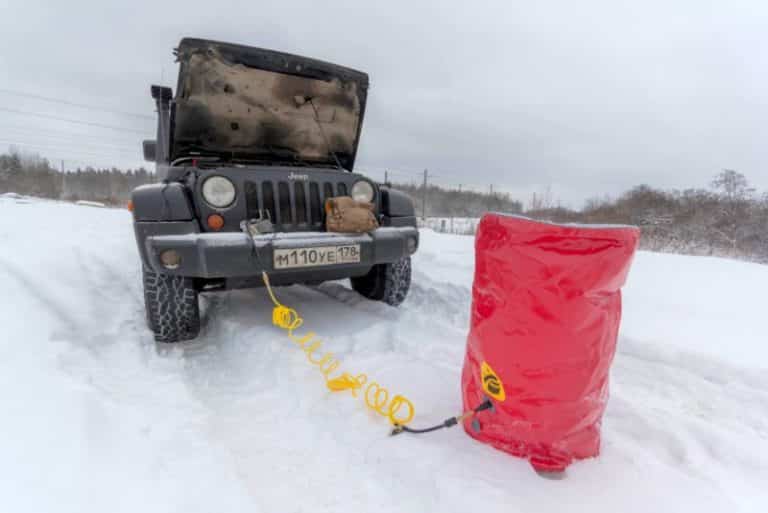How Do I Know If My Jeep Head Gasket Is Blown? (Let’s See)
Head Gasket in Jeeps plays a vital role in keeping different fluids in the required chamber. The separation ensures that each fluid plays its part in combustion.
A mixture of these fluids occurs as a result of blown head gaskets.
Knowing if your Jeep has a blown head gasket can save you severe replacement and engine maintenance costs. But the head gasket is not a component that you can readily check.
So how do you tell if this is the issue?
There are various signs that indicate that a Jeep’s head gasket is blown. Some of these signs include a change in color of your exhaust smoke, milky oil in the engine, and overheating of your engine. Identifying these signs, however, calls for a watch on your part as the vehicle user, which should help you stitch in time.
How Can You Tell the Head Gasket is Blown?

The most obvious way to identify a blown Jeep head gasket is by inspecting the smoke coming from the exhaust pipe. The smoke is waste released as a result of combustion.
If something is wrong in the combustion chamber of your engine, the type and color of smoke is one way to notice this wrong quickly.
However, one needs to understand the relationship between the combustion chamber, the exhaust smoke, and the head gasket of your Jeep.
This understanding helps to explain the smoke color being a sign of noticing a blown head gasket.
Your powerful Jeep has an engine with two major compartments. One area is where it all goes down.
First, the fuel and air enter; combustion happens due to the pistons, and the head gaskets seal this chamber to maintain pressure. The pressure creates the power to move the car.
The other compartment contains all the other fluid to restore the engine before it starts combustion again. The coolant helps bring down the engine’s temperature.
Oil to help lubricate necessary components is a part of this other side. The head gasket separates the two components and ensures fluid does not leak from one side to the other.
It also ensures that the various fluid passes through the right channel when performing individual actions.
Smoke exit the chamber through the exhaust pipe thanks to the head gaskets.
The head gasket maintains this process, but it has one major limitation. The efficiency of a Jeep head gasket depends mainly on the material.
When the engine overheats due to malfunction from other car components, it affects the head gasket.
When the temperature rises above the head gasket capability, the material expands irregularly, leading to leaks from one compartment to the other. This situation leads to what is called a blown head gasket.
You know you have a blown head gasket once there are leaks in your Jeep engine combustion chamber.
How do I Know if my Jeep Needs a Head Gasket?
A reduction in your Jeep’s performance is the first sign that something is wrong with your Jeep engine. Further inspection will help ascertain if your Jeep needs a new head jacket.
Three significant signs indicate when you need to be in the market for a new head gasket. It is essential to notice these signs and make adjustments before it requires buying a new engine.
The following are signs that indicate when you need a new head gasket for your Jeep.
#1. Engine Overheating
Several factors could lead to your Jeep engine overheating. However, one of that factors is the case of a blown head gasket.
A blown head gasket might prevent the coolant fluid from acting to cool down the engine.
An engine overheating can lead to a blown head gasket. A blown head gasket can also lead to engine overheating in other situations—a delightful irony of the automobile world.
If your engine is overheating, you might want to check the Jeep head gasket to check if it is the reason. Then, check to see if the overheating has affected the component in another situation.
In both scenarios, engine overheating relates closely to a blown head gasket.
#2. Colorful Exhaust Smoke
Exhaust smoke is usually colorless when your Jeep is in optimal condition. White smoke indicates something else.
This type of smoke evolves when the combustion chamber has the coolant leaking. When the oil enters the combustion chamber, you have blue smoke.
#3. Milky Oil
This sign is perhaps the most credible symptom pointing to blown head gaskets. Other signs can be a result of some other issues in your car.
However, a milky or discolored oil indicates a problem with your head gasket. Milky oil surfaces when the coolants are leaking into the oil chamber.
These three significant signs help you determine if your Jeep needs a new head gasket or not.
The model year of your Jeep can also affect how frequently you might need to change this component. Head gaskets of the older model have little resistance to high temperatures.
Newer versions of head gaskets are better at withstanding more elevated temperatures.
Can I Drive my Jeep with a Blown Head Gasket?
Your Jeep will run even with a blown head gasket. However, I advise you to stop using the vehicle until you make the necessary repairs.
Driving your Jeep with a blown head gasket is like adding fuel to the fire. In the worst-case scenario, this could be a literal occurrence.
Leakages from one chamber to another could lead to a fire in different engine parts. Another problem that arises is a reduction in fuel economy.
This problem is due to the decrease in pressure in your engine cylinder.
The reduced pressure means the engine consumes more fuel to meet up with power demand of the vehicle. Fuel also escapes with exhaust smoke.
Continuous driving can lead to irreplicable damage to your engine. So when you compare the cost of a new engine to that of a new head gasket, you’ll definitely realize what’s best.
What Does a Blown Head Gasket Sound Like?
A frequent sputtering sound from your engine indicates a blown head gasket. This sound is most common when this component is faulty.
If you have ever had an exhaust leak, you realize the sounds are similar to a blown head gasket.
That makes sense when you consider the effect of a blown head gasket. Exhaust leak is sure to follow when you have blown the head gasket. It explains why the sound that indicates both are similar.
This sound could be another way to notice any issue with your car. The sputtering sound becomes louder and more pronounced during acceleration.
That is because acceleration requires more power which means more combustion.
This sound is your Jeep engine drawing your attention to a severe issue with the fuel system. It is best to check the problem as soon as possible.
What Happens When the Head Gasket Fails?
There is a significant reduction in performance when a head gasket fails. While the car can still run, there is a reduction in top speed. The car runs poorly when this happens.
Another sign is that the engine idles roughly. This is because the combustion chamber produces power that is not useful for the car because of reducing pressure.
Misfiring is another issue to deal with when the head gasket fails. This misfiring happens when the components fail between the cylinders.
Misfiring is usually a sign of a leaking head gasket. However, it doesn’t necessarily have to be a blown head gasket.
A leaking head gasket allows fuel or gaseous combustion products into the coolants or the oil area. This leak results majorly in a reduction of pressure and very little more. Does Uconnect Need to be Updated?
What Does the Jeep Head Gasket Replacement Cost?

The average cost for replacing this component ranges between $2,300 and $2,600. This range includes the labor cost.
The purchase price is between $1,500 and $1,700, depending on the Jeep series and year of production.
The labor cost covers the rest, between $750 and $950. However, do not let the labor cost dissuade you from seeking professional help when replacing the head gasket.
It is better to replace than to repair the head gasket. Any error in head gasket replacement can lead to significant damage that eventually costs more to repair.
Also, note that this price may increase significantly if the issue has led to more damage. When the head gasket fails or leaks, you can check for signs to ascertain the problem.
Once you can confirm the issue, it is always cost-effective to repair it before significant damage occurs to the engine. How Do I Know if My Jeep Battery is Bad?
How to Tell if Your Car has a Blown Head Gasket
Closing Thoughts
The signs are there to determine if you have a blown head gasket. Take the clue, and make repairs that are due. And as much as you could, you continue to enjoy your Jeep.
When you have a new head gasket, it restores maximum pressure. Hence more power for your ride!






